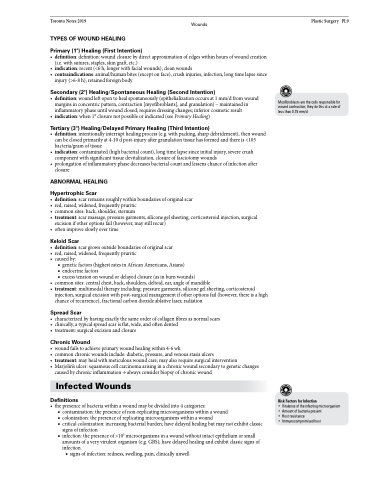Page 1131 - TNFlipTest
P. 1131
Toronto Notes 2019 Wounds TYPES OF WOUND HEALING
Primary (1°) Healing (First Intention)
• definition:definition:woundclosurebydirectapproximationofedgeswithinhoursofwoundcreation (i.e. with sutures, staples, skin graft, etc.)
• indication:recent(<6h,longerwithfacialwounds),cleanwounds
• contraindications:animal/humanbites(exceptonface),crushinjuries,infection,longtimelapsesince
injury (>6-8 h), retained foreign body
Secondary (2°) Healing/Spontaneous Healing (Second Intention)
• definition:woundleftopentohealspontaneously(epithelializationoccursat1mm/dfromwound margins in concentric pattern, contraction [myofibroblasts], and granulation) – maintained in inflammatory phase until wound closed; requires dressing changes; inferior cosmetic result
• indication:when1°closurenotpossibleorindicated(seePrimaryHealing)
Tertiary (3°) Healing/Delayed Primary Healing (Third Intention)
• definition:intentionallyinterrupthealingprocess(e.g.withpacking,sharpdebridement),thenwound can be closed primarily at 4-10 d post-injury after granulation tissue has formed and there is <105 bacteria/gram of tissue
• indication:contaminated(highbacterialcount),longtimelapsesinceinitialinjury,severecrush component with significant tissue devitalization, closure of fasciotomy wounds
• prolongationofinflammatoryphasedecreasesbacterialcountandlessenschanceofinfectionafter closure
ABNORMAL HEALING
Hypertrophic Scar
• definition:scarremainsroughlywithinboundariesoforiginalscar
• red,raised,widened,frequentlypruritic
• commonsites:back,shoulder,sternum
• treatment:scarmassage,pressuregarments,siliconegelsheeting,corticosteroidinjection,surgical
excision if other options fail (however, may still recur) • oftenimproveslowlyovertime
Keloid Scar
• definition:scargrowsoutsideboundariesoforiginalscar • red,raised,widened,frequentlypruritic
• causedby:
■ genetic factors (highest rates in African Americans, Asians)
■ endocrine factors
■ excess tension on wound or delayed closure (as in burn wounds)
• commonsites:centralchest,back,shoulders,deltoid,ear,angleofmandible
• treatment:multimodaltherapyincluding:pressuregarments,siliconegelsheeting,corticosteroid
injection, surgical excision with post-surgical management if other options fail (however, there is a high chance of recurrence), fractional carbon dioxide ablative laser, radiation
Spread Scar
• characterizedbyhavingexactlythesameorderofcollagenfibresasnormalscars • clinically,atypicalspreadscarisflat,wide,andoftendented
• treatment:surgicalexcisionandclosure
Chronic Wound
• woundfailstoachieveprimarywoundhealingwithin4-6wk
• commonchronicwoundsinclude:diabetic,pressure,andvenousstasisulcers
• treatment:mayhealwithmeticulouswoundcare;mayalsorequiresurgicalintervention
• Marjolin’sulcer:squamouscellcarcinomaarisinginachronicwoundsecondarytogeneticchanges
caused by chronic inflammation → always consider biopsy of chronic wound
Infected Wounds
Definitions
• thepresenceofbacteriawithinawoundmaybedividedinto4categories:
■ contamination: the presence of non-replicating microorganisms within a wound
■ colonization: the presence of replicating microorganisms within a wound
■ critical colonization: increasing bacterial burden; have delayed healing but may not exhibit classic
signs of infection
■ infection: the presence of >105 microorganisms in a wound without intact epithelium or small
amounts of a very virulent organism (e.g. GBS); have delayed healing and exhibit classic signs of infection
Plastic Surgery PL9
Myofibroblasts are the cells responsible for wound contraction; they do this at a rate of less than 0.75 mm/d
◆ signs of infection: redness, swelling, pain, clinically unwell
Risk Factors for Infection
• Virulence of the infecting microorganism • Amount of bacteria present
• Host resistance
• Immunocompromised host


